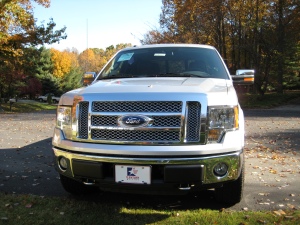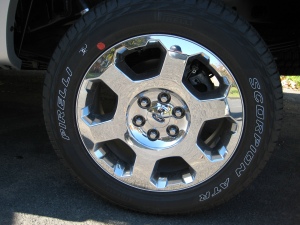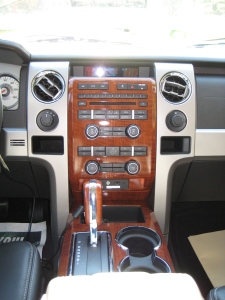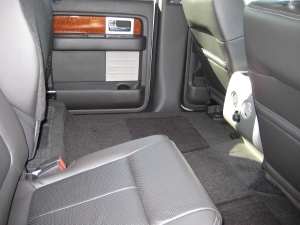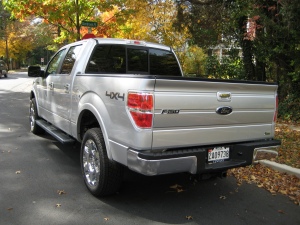Ford’s new 2010 F-150 is a direct shot at the recently redesigned Chevrolet and GMC trucks, as well as the new Dodge Ram. I have yet to review the Chevy or Dodge, but the F-150 impresses. For the last 15 years or so, American drivers have been switching from cars to trucks in droves, using them for more than just work. Automotive manufacturers have responded by adding more and more and more creature comforts and giving them more car-like rides. The fuel price spike in 2008 sent a lot of these buyers scrambling for hybrids and compacts, but many American drivers still need their trucks, and Ford has stepped up to the plate with a more refined ride and a redesigned interior. Ford hopes to keep truck buyers in the Ford family, as well as draw shoppers from competing brands (GM, Dodge and Toyota) with the new F-150, but have they created a compelling vehicle to keep the F-150 on top of the truck heap?
The F-150 has stood as the #1-selling truck in America for almost 30 years. That’s a lot of tradition, and a lot for the new truck to live up to, and the evolutionary design changes show you that this is a new truck. On the tester Lariat I drove, you also notice a lot of chrome, which comes with the Lariat Chrome Package ($1,420). The grille has a chrome wire mesh design, a departure from the honeycomb-styled grilles of recent past. The running boards have chrome bits on them as well, letting you know that this isn’t your average work truck. Moving towards the rear of the truck, the 4×4 badge on the bed sides lets you know it has the right equipment to get you through whatever the Pirelli Scorpion tires come across. These aren’t knobby tires, but provide good grip without making a lot of noise on the highway. The tires are a good compromise between on and off-road, better suited for hauling and towing than going into mud pits, but should give good grip in snow, provided it doesn’t get too deep.
When you step up into the truck, and you will be stepping up, you’re presented with a sea of hard plastic. While it looks like it will hold up to wear and time, the plastics undermine a truck whose (as tested) sticker steps into the $40,000 range. To break up the silver and black plastic, faux wood grained plastic was used on the center of the dash and around the gear shift lever. If you don’t like the wood grain, opt for the black center dash, which may require some different options. Resting your arms on the generously-sized center console and door arm rests, however, is a pleasure. The arm rests on the doors are made of soft-touch plastic, while the center console appears to be covered in a leatherette, matching the seat color. Moving on, the steering wheel is just the right size, and its thickness gives the driver the reassurance that they are at the helm of a big, tough vehicle. Buttons on the dashboard are laid out logically and are well designed, making it easy to find them at night. For a vehicle with no touch-screen navigation, the amount of knobs and buttons Ford used is about right, without overwhelming the driver. The biggest oversight in the interior, in my mind, is the lack of a grab handle for the driver. The passenger’s door has a grab handle in just the right place to allow you to swing up and into the truck, whereas the driver is left fumbling with the steering wheel or door frame to enter the cab of the pickup.
After turning the key to start the 5.4-liter Triton V8, the optional Sony 6-disc CD stereo comes to life. Its display is clear, and uses the same display as many other Ford vehicles, which is easy to read while providing adequate information. When listening to Sirius radio, for instance, a push of the “TEXT” button switches between displaying the song information and the channel information. Along with a clear display, clear sound will emanate from the audio system as well, with extra speakers mounted in the A pillar to reproduce higher notes separate from the door-mounted speakers. If you like a little extra thump in your audio, the Sony system will fit the bill, featuring a subwoofer mounted underneath part of the rear seat.
Speaking of the rear seats, they are large, and while not offering the same level of adjustment as the fronts, should provide your back seat passengers with plenty of comfort. Featuring the same leather used on the front seats, they split so that about two-thirds of the seat folds up onto the rear wall of the cabin. This allows for a flat and fairly large loading floor, good for hauling things which might blow away or would be weather-sensitive. The optional Sony subwoofer on the tester is bolted in, and removing that would allow you to use the floor space it consumed, making the flat load floor even larger. When hauling passengers instead of stuff, everyone will have plenty of leg room, as the F-150’s passenger compartment is simply huge.
While driving, you know you’re in a truck. The seating position is up high and makes you feel that you’re in command of the road. Looking around, you are able to see a great distance in any direction, which is a boon when stuck in traffic, as you can spot the cause of it easier. The squared-off corners of the F-150 make visibility and road placement easy, and in conjunction with the large side mirrors, makes it a breeze to keep the rather wide truck in your lane. The leather-trimmed captain’s chairs in the F-150 are comfortable, and the optional heated and cooled front seats are great for cold or hot days. I wouldn’t recommend getting into the truck muddy, however, as the leather seats are perforated for the cooling function and mud and other debris may cause them to stop functioning properly.
Given that the F-150 is a truck, many potential truck buyers want to know how well it will haul their toys, work equipment and loads in the bed. In that regard, the 5.4-liter V8 in the tester truck puts out 310 horsepower and 390 ft. lbs. of torque, good for towing 8,200 lbs. or 1,560 lbs. in the bed. If you don’t need the extra payload or towing capacity, you can save yourself some gas and money and opt for the 4.6-liter V8.
When fitting a truck with a cab like the Supercrew one on the tester, the manufacturer will put a shorter length bed on the truck, to ensure that the resulting truck will fit in standard parking spaces. With that in mind, the F-150 I drove has a bed which is 5’6″ long. While it might seem short, it is plenty wide, with 50 inches of space between the rear wheel arches. This leaves plenty of room for a 4×8′ sheet of plywood, provided you either use the bed-mounted tie-downs, or tie your load down to the optional bed extender. Either way, you’re going to have to leave the tailgate down, unless your cargo is rigid enough to be left leaning against it. Lifting cargo over the sides of the bed might be tough for shorter people, but with the “LiftAssist” feature Ford built into the tailgate (which makes it feel lighter than it is), getting cargo out of the back of the bed becomes a breeze.
Conclusion:
With this latest redesign, Ford has got themselves a truck which should do well against its competitors. It’s comfortable, quiet and roomy, for those who won’t use it just for work, while at the same time having the grunt that work trucks are needed for. With prices starting around $21,000 and climbing into the $60,000 range, there is a configuration for everyone, from the stripped-down regular cab, good for hauling work equipment, to the fully-loaded Platinum Edition, good for towing your boat and giving your friends room to ride in the same vehicle. It’s a shame that on the pricier models, such as the Lariat I tested, that Ford chose to use the same amount of plastic as in the more inexpensive models, but it appears they put the thought and time into getting the surfaces you touch on a constant basis to be easy to live with. While I didn’t much care for the wood grain plastic, Ford’s designers were thoughtful enough to offer other models with black plastic instead, bringing this truck’s interior up a notch. Overall, it’s a great truck, with not much to complain about, and given that Ford has made great strides with their cars as of late, it’s good to see that they are still taking the time and effort to put extra effort into their trucks. Even in today’s market of higher gas prices and the shift towards more fuel-efficient vehicles, trucks are still a part of the American automotive landscape, and probably will be for a long time to come.
Competitors: Chevrolet Silverado 1500, Dodge Ram 1500, GMC Sierra 1500, Toyota Tundra
As-Tested:
Year: 2010
Make: Ford
Model: F-150 4×4 SuperCrew Lariat (5.4L V8)
EPA Fuel Mileage: 14/18 City/Highway
Base Price: $38,710.00
Options:
$1,420: Lariat Chrome Package (angular step bar, chrome power heated side mirrors)
$435: Sony 6-disc CD + MP3
$995: 20″ Chrome Aluminum Wheels
$895: Leather Captains chairs (includes heated/cooled front chairs)
Total: $42,455
Destination: $975
As-Tested Price: $43,430
Ford has an online Window Sticker viewer. Click here to view the Window Sticker for the actual test vehicle.
Special thanks to Steve Fransisco and Century Ford of Mt. Airy, MD for loaning the tester to Road Reality. Click here to view their web site.
By John Suit


